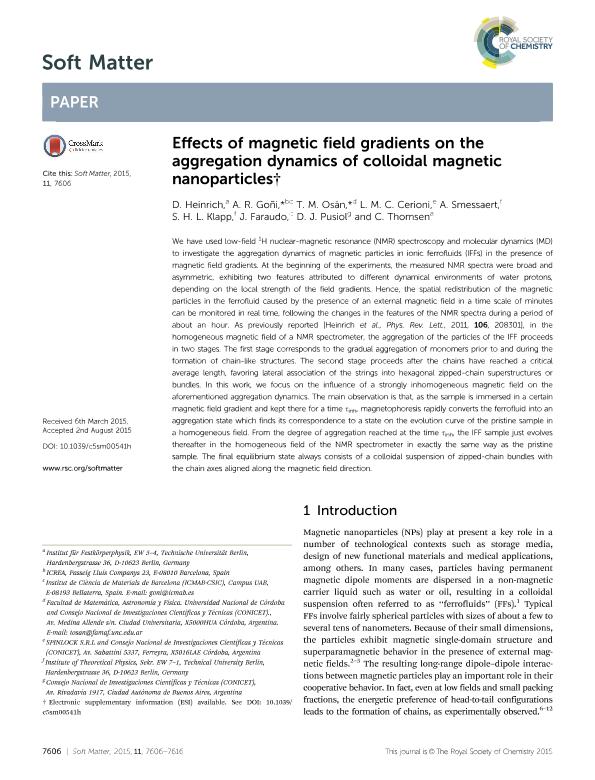Mostrar el registro sencillo del ítem
dc.contributor.author
Heinrich, D.
dc.contributor.author
Goñi, A. R.
dc.contributor.author
Osán, Tristán Martín

dc.contributor.author
Cerioni, Lucas Matias Ceferino

dc.contributor.author
Smessaert, A.
dc.contributor.author
Klapp, S. H. L.
dc.contributor.author
Faraudo, J.
dc.contributor.author
Pusiol, Daniel Jose

dc.contributor.author
Thomsen, C.
dc.date.available
2023-01-31T11:10:19Z
dc.date.issued
2015-08
dc.identifier.citation
Heinrich, D.; Goñi, A. R.; Osán, Tristán Martín; Cerioni, Lucas Matias Ceferino; Smessaert, A.; et al.; Effects of magnetic field gradients on the aggregation dynamics of colloidal magnetic nanoparticles; Royal Society of Chemistry; Soft Matter; 11; 38; 8-2015; 7606-7616
dc.identifier.issn
1744-683X
dc.identifier.uri
http://hdl.handle.net/11336/186220
dc.description.abstract
We have used low-field 1H nuclear-magnetic resonance (NMR) spectroscopy and molecular dynamics (MD) to investigate the aggregation dynamics of magnetic particles in ionic ferrofluids (IFFs) in the presence of magnetic field gradients. At the beginning of the experiments, the measured NMR spectra were broad and asymmetric, exhibiting two features attributed to different dynamical environments of water protons, depending on the local strength of the field gradients. Hence, the spatial redistribution of the magnetic particles in the ferrofluid caused by the presence of an external magnetic field in a time scale of minutes can be monitored in real time, following the changes in the features of the NMR spectra during a period of about an hour. As previously reported [Heinrich et al., Phys. Rev. Lett., 2011, 106, 208301], in the homogeneous magnetic field of a NMR spectrometer, the aggregation of the particles of the IFF proceeds in two stages. The first stage corresponds to the gradual aggregation of monomers prior to and during the formation of chain-like structures. The second stage proceeds after the chains have reached a critical average length, favoring lateral association of the strings into hexagonal zipped-chain superstructures or bundles. In this work, we focus on the influence of a strongly inhomogeneous magnetic field on the aforementioned aggregation dynamics. The main observation is that, as the sample is immersed in a certain magnetic field gradient and kept there for a time τinh, magnetophoresis rapidly converts the ferrofluid into an aggregation state which finds its correspondence to a state on the evolution curve of the pristine sample in a homogeneous field. From the degree of aggregation reached at the time τinh, the IFF sample just evolves thereafter in the homogeneous field of the NMR spectrometer in exactly the same way as the pristine sample. The final equilibrium state always consists of a colloidal suspension of zipped-chain bundles with the chain axes aligned along the magnetic field direction.
dc.format
application/pdf
dc.language.iso
eng
dc.publisher
Royal Society of Chemistry

dc.rights
info:eu-repo/semantics/openAccess
dc.rights.uri
https://creativecommons.org/licenses/by-nc-sa/2.5/ar/
dc.subject
NANO PARTICLES
dc.subject
MAGNETIC RESONANCE
dc.subject
COLLOIDS
dc.subject
MAGNETIC PARTICLES
dc.subject.classification
Física Atómica, Molecular y Química

dc.subject.classification
Ciencias Físicas

dc.subject.classification
CIENCIAS NATURALES Y EXACTAS

dc.title
Effects of magnetic field gradients on the aggregation dynamics of colloidal magnetic nanoparticles
dc.type
info:eu-repo/semantics/article
dc.type
info:ar-repo/semantics/artículo
dc.type
info:eu-repo/semantics/publishedVersion
dc.date.updated
2023-01-26T17:35:16Z
dc.journal.volume
11
dc.journal.number
38
dc.journal.pagination
7606-7616
dc.journal.pais
Reino Unido

dc.description.fil
Fil: Heinrich, D.. Technishe Universitat Berlin; Alemania
dc.description.fil
Fil: Goñi, A. R.. Consejo Superior de Investigaciones Científicas. Instituto de Ciencia de los Materiales de Barcelona; España
dc.description.fil
Fil: Osán, Tristán Martín. Consejo Nacional de Investigaciones Científicas y Técnicas. Centro Científico Tecnológico Conicet - Córdoba. Instituto de Física Enrique Gaviola. Universidad Nacional de Córdoba. Instituto de Física Enrique Gaviola; Argentina
dc.description.fil
Fil: Cerioni, Lucas Matias Ceferino. Spinlock S.r.l; Argentina. Consejo Nacional de Investigaciones Científicas y Técnicas; Argentina
dc.description.fil
Fil: Smessaert, A.. Technishe Universitat Berlin; Alemania
dc.description.fil
Fil: Klapp, S. H. L.. Technishe Universitat Berlin; Alemania
dc.description.fil
Fil: Faraudo, J.. Consejo Superior de Investigaciones Científicas. Instituto de Ciencia de los Materiales de Barcelona; España
dc.description.fil
Fil: Pusiol, Daniel Jose. Consejo Nacional de Investigaciones Científicas y Técnicas; Argentina
dc.description.fil
Fil: Thomsen, C.. Technishe Universitat Berlin; Alemania
dc.journal.title
Soft Matter

dc.relation.alternativeid
info:eu-repo/semantics/altIdentifier/doi/http://dx.doi.org/10.1039/c5sm00541h
Archivos asociados
